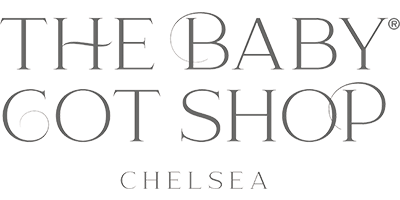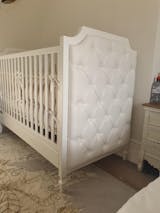Welcoming a baby is a joyous, life-changing experience for parents and caregivers. And in parenthood, one of your foremost priorities is to create a safe, nurturing environment where your baby can thrive. The nursery, in particular, becomes the epicentre of your baby's world, and it is crucial to meticulously set up this space with safety as the top concern. In this blog, we will look into the various aspects of 'baby-proofing' your nursery and the wider home, equipping you with practical tips and strategies to safeguard your child's well-being. From baby nursery safety to toxin-free setups, these guidelines will ensure that you have the confidence and peace of mind to welcome your baby into a truly safe and secure environment. Ready?
NURSERY SAFETY
The nursery is the heart of your baby's universe, a place that must be thoughtfully set up to ensure maximum safety and security. How do you make this happen? Here are the areas you need to pay attention to:
- Cot Considerations: Selecting the right cot is paramount. A sturdy, well-constructed model that meets the latest safety standards is your best friend. Ensure that the mattress fits snugly, with no gaps around the edges where your baby's head could become trapped. Steer clear of or do away with any loose bedding, pillows, or objects that could pose a suffocation risk, as these can be extremely hazardous for infants who are unable to roll over or move independently. Find out what makes the perfect cot here.
- Furniture Anchoring: Secure all heavy furniture, such as dressers and bookcases, to the wall using sturdy brackets or straps. In doing so, you prevent these items from tipping over and potentially crushing or trapping your baby, especially as they become more mobile and curious.
- Electrical Outlets: Cover all electrical outlets with tamper-resistant covers or safety plugs to prevent your baby from inserting their fingers or small objects into the sockets. Tuck away any loose cords or cables to eliminate the risk of strangulation or choking. Also consider installing childproof door and drawer locks to restrict access to potentially dangerous areas, such as those housing electrical equipment.
- Windows and Window Treatments: Install window guards or safety latches to prevent your baby from falling out of open windows. This is important, especially as your child grows more curious and adventurous, and may attempt to lean or climb on the windowsill. Additionally, opt for cordless window treatments to avoid the risk of strangulation, as dangling cords pose a potential risk.
- Temperature: Ensure that the nursery maintains a comfortable and consistent temperature, using a reliable thermometer and adjusting the heating or cooling as needed. Extreme temperatures, whether hot or cold, can pose serious health risks for your baby, potentially leading to heat exhaustion, hypothermia, or other conditions.
- Lighting: Choose soft, indirect lighting that won't strain your baby's delicate eyes. Avoid using candles or lamps with exposed bulbs, which could become fire hazards if knocked over or touched by your baby's curious little hands.
- Toxin-Free Finishes: Select furniture, fabrics, and decor that are free from harmful chemical finishes and volatile organic compounds (VOCs). This helps create a healthier, more breathable environment for your child, minimising their exposure to potential irritants or toxins that could adversely affect their health.
MAKING YOUR ENTIRE HOME SAFE FOR YOUR BABY
After creating a safe baby nursery, it is essential to extend your safety measures throughout your entire living space. Again, here are the areas you need to pay attention to:
- Stairways: Install sturdy baby gates at the top and bottom of staircases to prevent falls. Since poorly installed gates can become dislodged and pose serious hazards themselves, ensure that they are properly secured and meet safety standards.
- Flooring: Identify and address any uneven or slippery flooring, such as loose tiles or hardwood planks, and consider using non-slip mats or rugs to create a safer surface for your baby to walk on. Crawling infants and newly walking toddlers are particularly vulnerable to falls on slippery floors, so this can go a long way in protecting your baby.
- The Kitchen: Keep all sharp objects, such as knives, scissors, and kitchen tools, well out of your child's reach. Also, store cleaning supplies, medications, and other potentially toxic substances in high, secured cabinets equipped with safety latches.
- The Bathroom: Install non-slip mats in the bathtub and shower to prevent falls, and keep medicines, toiletries, and cleaning products stored in high, secured cabinets. Always supervise your child closely during bath times if you use a bath tub to prevent drowning too.
- Fireplace and Heating Safeguards: Install fireplace guards or covers to prevent your baby from accessing the flames or hot surfaces. Ensure that any heating sources are properly secured and out of your child's reach. Burns and scalds are serious risks, so these precautions are necessary.
- Poison Prevention: Identify and safely store any potentially toxic substances, such as household cleaners, paints, and medications, in locked cabinets or out of your child's reach, as accidental ingestion can have serious consequences.
- Outdoors: Be mindful of potential hazards like pools, ponds, or unfenced yards when your baby ventures outdoors. Always supervise your baby and consider installing appropriate safety barriers, such as fencing or pool covers, to prevent access to these dangerous areas.
MAKING SURE YOUR CHILD DOES NOT OUTGROW SAFETY MEASURES
As your baby grows and develops, their needs and the potential safety risks in your home will evolve. It is crucial to maintain a proactive and adaptable approach to ensure your child's well-being. Here's how:
- Continuous Evaluation: Regularly inspect your home, paying attention to any changes or new potential hazards. Adjust your safety measures accordingly as your child becomes more mobile and curious, climbing higher, reaching further, and exploring new areas of the house. What may have been safe for a newborn may quickly become a danger for a crawling or walking infant.
- Safety Upgrades: Be prepared to upgrade or replace safety devices as your child grows. Items like outlet covers and baby gates may need to be repositioned or swapped for more advanced models to maintain effectiveness. Anticipate your child's increasing strength, dexterity, and problem-solving skills, and adapt your home's safeguards to stay one step ahead.
- Stay Informed: Stay up-to-date with the latest safety recommendations and product recalls. Join parent support groups or follow reputable online resources to stay informed about emerging safety concerns. Child safety is ever-evolving, and remaining vigilant about new risks and best practices is important.
- Emergency Preparedness: Ensure that you have a well-stocked first-aid kit, and familiarise yourself with basic emergency procedures. Consider taking a first-aid course to be prepared for any unexpected situations. Accidents can happen, even in the most 'baby-proofed' homes, so being equipped to respond swiftly and effectively can make all the difference.
- Educate Your Child: As your baby grows, gradually introduce age-appropriate safety education. Teach your child about the importance of safety and empower them to identify and avoid potential hazards. This will lay the foundation for a lifelong understanding of personal safety and risk management.
Creating a safe and secure environment for your baby is a responsibility that every parent must embrace with dedication. By implementing the strategies and considerations outlined here, you can provide your child or ward with a nurturing, hazard-free space to grow, explore, and thrive. Remember, it is an ongoing process that requires vigilance, adaptability, and a commitment to your child's well-being. With a proactive approach and an understanding of safety best practices though, you can rest assured that your baby is protected and free to enjoy the wonders of their early years.
P.S.: The best nursery pieces for your child are those that meet latest safety standards. The best place to find them? Right here. All nursery pieces at The Baby Cot Shop — from cots to cribs and moses baskets, chair and table sets, other safe baby furniture, mobiles, bedding etc — meet the very latest European safety standards for baby nurseries. So, if you're looking to set up your baby's home with an assurance of safety and security, browse through our collections, make your picks and you can be sure of a seamless and hassle-free experience. That's a certainty.


